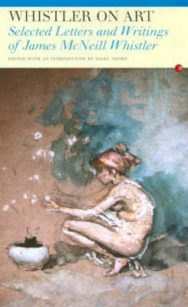
ABOUT THIS BOOK
PUBLISHER: Carcanet Press Ltd
FORMAT: Paperback
ISBN: 9781857547641
RRP: £9.95
PAGES: 240
PUBLICATION DATE:
August 26, 2004
BUY THIS BOOK
As an Amazon Associate and Bookshop.org affiliate we earn from qualifying purchases.
Whistler on Art
James Abbott McNeill Whistler
Nigel Thorp
James McNeill Whistler (1834-1903), the American-born painter and etcher, became a crucial link between the Paris and London art worlds of the mid-nineteenth century. Influenced first by Courbet’s realism, he evolved his own distinctive aesthetic, stressing ‘an arrangement of line, form and colour first’. His Nocturnes are among the most highly-regarded of his works. He wrote more than 5,000 letters which, with his published writing and conversations, illuminate his work and his contentious relations with the art world of the time. Whistler on Art includes seventy-five items: letters (many not published before) and material recording his disillusionment with English approaches to art and his response to the French, Scottish and American art worlds. Whistler was a friend of the Pre-Raphaelites and enjoyed a fruitful dialogue with Swinburne and with Wilde (whom he later accused of plagiarism) and emerged at the centre of the Aesthetic Movement. Against Ruskin (who attacked him) he won a libel suit and a farthing’s damages. The trial sharpened Whistler’s polemical gifts, and he wrote stinging pamphlets and letters to the press. In his Ten O’Clock Lecture he attacked Ruskin’s view of t
Reviews of Whistler on Art
'It is quite possible to be charmed by the sardonic and elusive wit of Whistler's writing while at the same time to be infuriated by his self-opinionated arrogance, a paradox which would, no doubt, have appealed to the artist.' The Burlington Magazine 'This is a fascinating glimpse into the mind of a remarkable artist who can still reveal surprises in his painting after a century.' Books in Scotland
James Abbott McNeill Whistler
Nigel Throp is the director of the Centre for Whistler Studies at the University of Glasgow.









